Iceland Travel Tips, provided by SIXT.VN, will make your trip to this stunning country unforgettable. We’ll show you how to navigate Iceland’s unique environment and culture, offering practical advice for a seamless travel experience. Learn about the best times to visit, how to pack, and ways to save money while enjoying the natural wonders and cultural experiences Iceland has to offer.
1. Embrace Iceland’s Unpredictable Weather: Pack Smartly
Iceland’s weather is notoriously unpredictable. Be ready for anything, even in summer.
The weather in Iceland can change rapidly. This means you need to pack accordingly. Even in the height of summer, you might encounter snow, especially in higher altitudes. According to a weather study by the Icelandic Meteorological Office in 2023, temperature fluctuations can occur within hours, emphasizing the need for adaptable clothing. The key is to dress in layers. Start with a moisture-wicking base layer, add an insulating mid-layer (like fleece or wool), and finish with a waterproof and windproof outer shell. Don’t forget essentials like a warm hat, gloves, and a scarf. Sturdy hiking boots are a must if you plan on exploring Iceland’s rugged terrain. And remember, a good quality tent is crucial if you intend to camp.
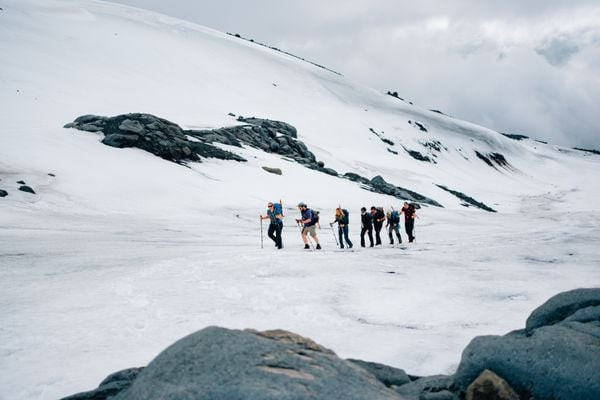 Expect snow at any time of year in Iceland, especially at higher altitudes. Photo: Tom Barker.
Expect snow at any time of year in Iceland, especially at higher altitudes. Photo: Tom Barker.
1.1 What Specific Clothing Items Should I Pack For Iceland?
Pack versatile clothing items that can be layered to adapt to changing weather conditions.
Here’s a list of essential clothing items to pack for your Iceland adventure:
- Base Layers: Moisture-wicking fabrics like merino wool or synthetic materials.
- Mid-Layers: Fleece or wool sweaters for insulation.
- Outer Layer: Waterproof and windproof jacket and pants.
- Hiking Boots: Sturdy and waterproof with good ankle support.
- Warm Hat, Gloves, and Scarf: Essential for warmth, especially during colder months.
- Swimsuit: For enjoying Iceland’s geothermal pools.
1.2 How Can I Stay Updated on Iceland’s Weather Forecast?
Staying updated on the weather forecast can help you plan your activities and dress accordingly.
The Icelandic Meteorological Office (vedur.is) provides accurate and up-to-date weather forecasts for Iceland. Check the forecast daily and be prepared to adjust your plans based on the conditions. Several weather apps are also available for smartphones, providing real-time updates and alerts. Keep an eye on wind speed, precipitation, and temperature to ensure you’re prepared for any weather eventuality.
2. Discover Iceland’s Breathtaking Beauty, Rain or Shine
Iceland’s beauty is undeniable, and it’s worth exploring no matter the weather.
Iceland’s dramatic landscapes are a sight to behold, and the variable weather only enhances their allure. According to the Icelandic Tourist Board, over 2 million tourists visited Iceland in 2019, drawn by its unique geological formations and stunning natural phenomena. Even on cloudy or rainy days, Iceland’s beauty shines through. Storms can create dramatic seascapes, while snow can transform lava fields into monochromatic masterpieces. Don’t let the weather deter you from exploring Iceland’s glaciers, lava fields, fjords, and volcanic mountains. You’ll find yourself reaching for your camera again and again.
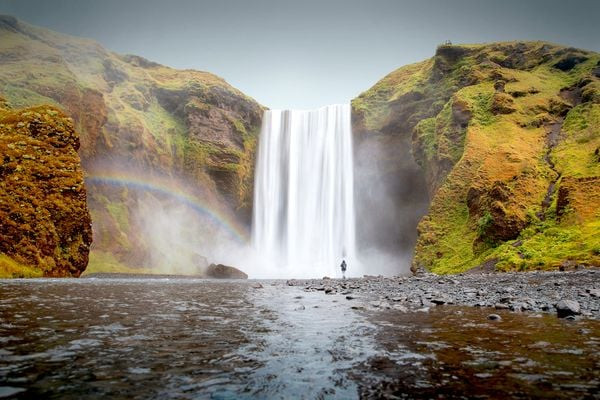 Skogafoss, Iceland.
Skogafoss, Iceland.
2.1 What Are Some Must-See Natural Attractions In Iceland?
Iceland is home to numerous natural attractions that are worth visiting, regardless of the weather.
Here are some must-see natural attractions in Iceland:
- The Golden Circle: A popular route that includes Þingvellir National Park, Gullfoss waterfall, and the Geysir geothermal area.
- The Blue Lagoon: A geothermal spa known for its milky blue water and therapeutic properties.
- The South Coast: Home to black sand beaches, glaciers, waterfalls, and the Jökulsárlón glacier lagoon.
- The Northern Lights: A natural light display that can be seen during the winter months.
- The Westfjords: A remote and rugged region with stunning fjords, mountains, and wildlife.
2.2 How Can I Make The Most Of My Trip To Iceland In Bad Weather?
Embrace the weather and focus on indoor activities or attractions that are best experienced in certain conditions.
Even in bad weather, Iceland offers plenty of opportunities for adventure. Consider visiting museums, art galleries, or geothermal pools. Stormy weather can create dramatic landscapes, perfect for photography. The Northern Lights are often more visible during clear, cold nights. Remember, there’s no bad weather, just unsuitable clothing.
3. Consider Guided Tours For The Laugavegur Trek
If you’re planning to trek the Laugavegur trail, consider joining a guided tour to ease the burden of carrying heavy gear.
Trekking the Laugavegur trail is an unforgettable experience, but it can be challenging if you’re carrying all your own food and gear. According to a study by the Icelandic Hiking Association, hikers carrying heavy packs reported higher levels of fatigue and discomfort. Guided tours offer a convenient alternative, as they provide meals, accommodation, and porter services. This allows you to focus on enjoying the stunning scenery without the added burden of carrying a heavy backpack. Alternatively, you could “fastpack” the route over two or three days to minimize the weight you need to carry.
 A guided group on the Laugavegur trek. Photo: Icelandic Mountain Guides.
A guided group on the Laugavegur trek. Photo: Icelandic Mountain Guides.
3.1 What Are The Benefits Of Joining A Guided Tour For The Laugavegur Trek?
Joining a guided tour can make your Laugavegur trek more enjoyable and less physically demanding.
Here are some benefits of joining a guided tour for the Laugavegur trek:
- Reduced Physical Burden: You won’t have to carry heavy food and camping gear.
- Comfortable Accommodation: Guided tours often include accommodation in huts or lodges along the trail.
- Delicious Meals: Enjoy hearty and nutritious meals prepared by experienced chefs.
- Expert Guidance: Benefit from the knowledge and expertise of experienced guides.
- Safety and Support: Guides provide safety briefings, navigation assistance, and emergency support.
3.2 How Can I Prepare For A Self-Supported Trek On The Laugavegur Trail?
If you choose to trek the Laugavegur trail independently, proper preparation is essential.
Here are some tips for preparing for a self-supported trek on the Laugavegur trail:
- Pack Light: Minimize the weight of your backpack by choosing lightweight gear and packing only essentials.
- Plan Your Meals: Pack energy-rich and easy-to-prepare meals.
- Test Your Gear: Ensure your hiking boots, tent, and other gear are in good condition.
- Study The Route: Familiarize yourself with the trail and potential hazards.
- Check The Weather: Monitor the weather forecast and be prepared for changing conditions.
4. Skip The Blue Lagoon: Discover Iceland’s Local Pools
While the Blue Lagoon is famous, Iceland’s local pools offer a more authentic and affordable experience.
The Blue Lagoon is a popular tourist attraction, but it can be expensive and crowded. According to a survey by the Icelandic Travel Industry Association, many tourists are seeking more authentic experiences. Local swimming pools offer a great alternative, providing a chance to relax, socialize, and experience Icelandic culture. These pools are geothermally heated and are open year-round. Many have indoor and outdoor pools, as well as hot tubs and saunas.
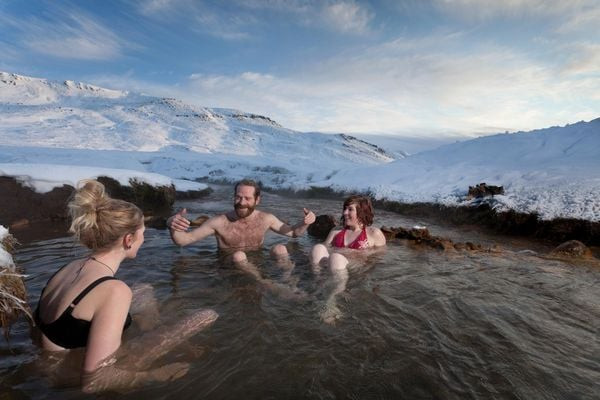 Socialising in one of Iceland
Socialising in one of Iceland
4.1 What Are The Benefits Of Visiting Local Swimming Pools In Iceland?
Visiting local swimming pools offers a more authentic and affordable experience compared to the Blue Lagoon.
Here are some benefits of visiting local swimming pools in Iceland:
- Affordability: Local pools are much cheaper than the Blue Lagoon.
- Authenticity: Experience Icelandic culture and socialize with locals.
- Relaxation: Enjoy geothermally heated pools, hot tubs, and saunas.
- Year-Round Access: Local pools are open year-round, even in winter.
- Community: Swimming is a popular activity in Iceland, and local pools are a gathering place for communities.
4.2 What Should I Expect When Visiting A Local Swimming Pool In Iceland?
Be prepared to follow the pool’s etiquette and hygiene rules.
When visiting a local swimming pool in Iceland, be prepared to follow the pool’s etiquette and hygiene rules. It’s customary to shower thoroughly before entering the pool, without wearing a swimsuit. You’ll also need to wear a swimsuit in the pool. Many pools have separate changing rooms for men and women. Be respectful of other visitors and keep noise levels down.
5. Save Money On Transport With Carpooling
Carpooling is an affordable and environmentally friendly way to travel around Iceland.
Renting a car is a popular way to explore Iceland, but it can be expensive, especially for solo travelers. According to a report by the Icelandic Environment Association, carpooling can significantly reduce transportation costs and carbon emissions. Carpooling websites like Samferda allow you to connect with other travelers and share rides. This is a great way to save money, meet new people, and reduce your environmental impact.
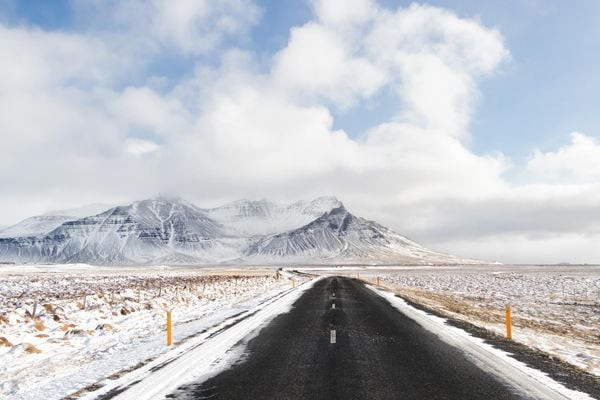 Roads in Iceland. Photo: Getty.
Roads in Iceland. Photo: Getty.
5.1 How Does Carpooling Work In Iceland?
Carpooling websites and hostel bulletin boards are great resources for finding ride-sharing opportunities.
Carpooling in Iceland is easy. You can use carpooling websites like Samferda to find rides or offer your own. Simply create a profile, search for rides that match your itinerary, and contact the driver or passengers. Many hostels also have bulletin boards where you can post or find ride-sharing opportunities. Petrol costs are typically split among the passengers.
5.2 What Are The Benefits Of Carpooling In Iceland?
Carpooling is a cost-effective and sustainable way to travel around Iceland.
Here are some benefits of carpooling in Iceland:
- Cost Savings: Reduce transportation costs by sharing petrol expenses.
- Environmental Impact: Lower your carbon footprint by sharing rides.
- Social Interaction: Meet new people and share travel experiences.
- Flexibility: Find rides that match your itinerary and schedule.
- Convenience: Avoid the hassle of renting a car and navigating unfamiliar roads.
6. Avoid Fish Oil For Breakfast: A Culinary Warning
While trying local cuisine is a great way to experience Icelandic culture, some dishes may not be to everyone’s taste.
Icelandic cuisine is unique and diverse, but some dishes may not be to everyone’s liking. Lýsi, or cod liver oil, is a traditional Icelandic supplement taken for its health benefits. However, its pungent taste can be off-putting, especially first thing in the morning. While it’s good to try new things, be prepared for a strong and potentially unpleasant flavor.
 Icelandic breakfast, including fish oil shots. Photo: Icelandic Mountain Guides.
Icelandic breakfast, including fish oil shots. Photo: Icelandic Mountain Guides.
6.1 What Is Lýsi And Why Do Icelanders Take It?
Lýsi is a traditional Icelandic supplement made from cod liver oil, rich in vitamins and omega-3 fatty acids.
Lýsi is a traditional Icelandic supplement made from cod liver oil. It’s rich in vitamins A and D, as well as omega-3 fatty acids. Icelanders take Lýsi for its health benefits, including supporting immune function, bone health, and cardiovascular health. It’s often taken during the winter months when sunlight exposure is limited.
6.2 What Are Some Alternative Icelandic Foods To Try?
Icelandic cuisine offers many delicious and unique dishes worth trying.
If Lýsi isn’t your cup of tea, there are plenty of other Icelandic foods to try:
- Skyr: A traditional Icelandic yogurt, high in protein and low in fat.
- Lamb Soup (Kjötsúpa): A hearty and flavorful soup made with lamb and root vegetables.
- Fish Stew (Plokkfiskur): A creamy and comforting stew made with fish, potatoes, and onions.
- Rye Bread (Rúgbrauð): A dense and slightly sweet bread baked in geothermal ovens.
- Icelandic Hot Dogs (Pylsur): A local favorite, made with lamb and topped with onions, mustard, and remoulade.
7. Fuel Up With Hot Dogs And Soup: Budget-Friendly Eats
Eating out in Iceland can be expensive, but hot dogs and soup are affordable and delicious options.
Iceland is known for being an expensive country, especially when it comes to dining out. According to a cost of living survey by Numbeo in 2024, Reykjavik is one of the most expensive cities in Europe for dining. However, there are ways to save money on food. Hot dogs and soup are popular and budget-friendly options. Hot dogs, known as “pylsur,” are made with locally-sourced lamb and topped with a variety of condiments. Many restaurants also offer a daily soup option, which is a filling and affordable meal.
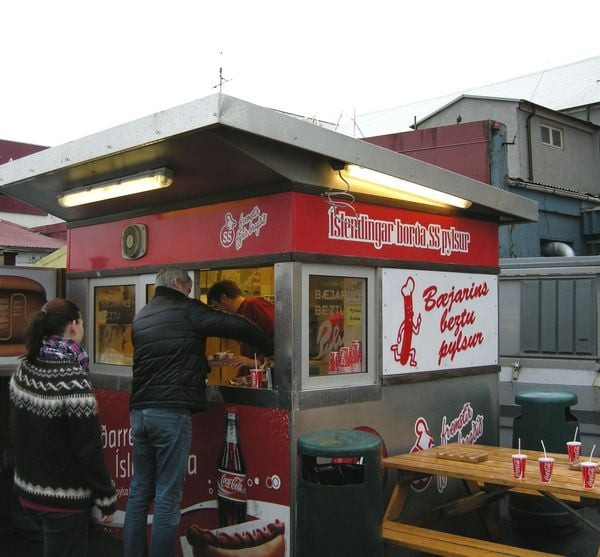 Bæjarins Beztu Pylsur, Reykjavik's most famous hot dog stand. Photo: Wikimedia Commons.
Bæjarins Beztu Pylsur, Reykjavik's most famous hot dog stand. Photo: Wikimedia Commons.
7.1 Where Can I Find The Best Hot Dogs In Iceland?
Hot dog stands can be found in almost every town in Iceland, offering a quick and affordable meal.
You can find hot dog stands in practically every town you visit in Iceland. Bæjarins Beztu Pylsur in Reykjavik is one of the most famous hot dog stands in the country, known for its delicious and affordable pylsur. These hot dogs are made with locally-sourced lamb and topped with a mixture of raw and crispy fried onions, sweet brown mustard, and remoulade, a sauce made with mayonnaise, capers, and herbs.
7.2 What Types Of Soup Are Popular In Iceland?
Icelandic soups are hearty and flavorful, often featuring lamb or seafood.
Icelandic soups tend to be hearty and flavor-packed. Kjötsúpa is a rich broth containing chunks of slow-cooked lamb and root vegetables. Humarsúpa is a creamy bisque made with langoustines. These soups are perfect for warming up after a blustery coastal walk.
8. Plan Your Iceland Adventure with SIXT.VN
SIXT.VN can help you plan your perfect Iceland adventure, offering services like airport transfers, hotel bookings, and tour packages.
Planning a trip to Iceland can be overwhelming, but SIXT.VN is here to help. We offer a range of services to make your trip seamless and stress-free. From airport transfers to hotel bookings and tour packages, we can take care of all the details so you can focus on enjoying your adventure.
SIXT.VN understands the challenges travelers face, such as language barriers, finding reliable services, and navigating transportation. That’s why we offer comprehensive solutions tailored to your needs. Our services include:
- Personalized Travel Itineraries: Customized to your interests and timeframe.
- Airport Transfers: Safe and convenient transportation from the airport to your hotel.
- Hotel Bookings: A wide selection of accommodations to fit your budget and preferences.
- Sightseeing Tours: Expert-led tours to Iceland’s most famous attractions.
- Flight Bookings: Assistance with finding the best flight deals and schedules.
Contact SIXT.VN today to start planning your dream Iceland vacation. Visit our website at SIXT.VN or call us at +84 986 244 358 for personalized assistance.
Address: 260 Cau Giay, Hanoi, Vietnam.
9. Understanding User Search Intent For Iceland Travel
To create content that resonates with readers, it’s essential to understand their search intent. Here are five key user search intents related to “Iceland Travel Tips”:
- Informational: Users seeking basic information and guidance for planning their trip, such as the best time to visit, what to pack, and things to do.
- Navigational: Users looking for specific websites or services related to Iceland travel, such as booking accommodations, tours, or transportation.
- Transactional: Users ready to make a purchase, such as booking flights, hotels, or tours in Iceland.
- Commercial Investigation: Users researching the best options for specific travel products or services, comparing prices, features, and reviews.
- Local: Users searching for local businesses or attractions in Iceland, such as restaurants, shops, or activities near their location.
By understanding these search intents, content creators can tailor their content to meet the specific needs and expectations of their audience.
10. Frequently Asked Questions About Iceland Travel
Here are some frequently asked questions about Iceland travel to help you plan your trip:
10.1 What Is The Best Time To Visit Iceland?
The best time to visit Iceland depends on your interests. Summer (June-August) offers long daylight hours and mild temperatures, ideal for hiking and outdoor activities. Winter (November-March) is the best time to see the Northern Lights, but be prepared for shorter days and colder weather.
10.2 How Expensive Is It To Travel To Iceland?
Iceland is generally an expensive country to visit. Accommodation, food, and transportation costs can be high. However, there are ways to save money, such as traveling during the shoulder season, cooking your own meals, and using public transportation or carpooling.
10.3 What Are Some Must-See Attractions In Iceland?
Some must-see attractions in Iceland include the Golden Circle, the Blue Lagoon, the South Coast, the Northern Lights, and the Westfjords.
10.4 What Should I Pack For A Trip To Iceland?
Pack warm layers, waterproof outerwear, sturdy hiking boots, and a swimsuit for visiting geothermal pools. Don’t forget essentials like a warm hat, gloves, and a scarf.
10.5 How Can I Get Around In Iceland?
Renting a car is a popular way to explore Iceland, but public transportation and carpooling are also options. Some areas, like the Highlands, require a 4×4 vehicle.
10.6 Is It Safe To Drink The Tap Water In Iceland?
Yes, the tap water in Iceland is safe and clean to drink. It’s sourced from natural springs and glaciers and doesn’t require any treatment.
10.7 What Is The Currency Used In Iceland?
The currency used in Iceland is the Icelandic króna (ISK). Credit and debit cards are widely accepted, but it’s a good idea to have some cash on hand for smaller establishments or remote areas.
10.8 What Language Do They Speak In Iceland?
The official language of Iceland is Icelandic. English is widely spoken, especially in tourist areas.
10.9 Are There Any Cultural Customs I Should Be Aware Of?
Icelanders are generally friendly and welcoming. It’s customary to remove your shoes when entering someone’s home. Bathing suits are required in geothermal pools.
10.10 What Should I Do In Case Of Emergency?
In case of emergency, dial 112 for police, fire, or ambulance services.
By following these Iceland travel tips, you can ensure a safe, enjoyable, and unforgettable trip to this incredible country. Remember to plan ahead, pack accordingly, and be prepared for anything. With the right preparation, you can experience the best that Iceland has to offer.



